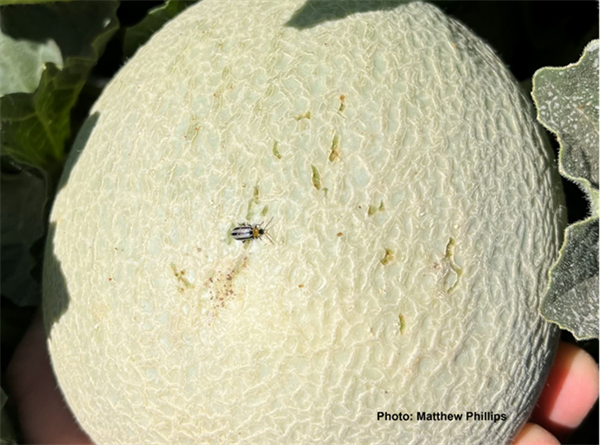Springtails: There have been a couple of reports of springtails found swarming the netted fruit of cantaloupes (WATCH VIDEO). They were also abundant in the soil surrounding the fruit. However, at this point there is no sign that they are feeding on the fruit. This would be unusual as springtails primarily develop in the soil, feeding on fungi, algae, and decaying plant matter. They tend to be heaviest on heavily irrigated soil. A few species will feed on germinating seeds and young seedlings of lettuce and brassica plants, but I’ve rarely seen them cause damage in Yuma. Plus, there is no literature suggesting they will feed on immature or maturing melon fruit. But you never know. If you find these little critters in or on your melons keep a close eye on them. If you suspect they are causing damage, please give me call.
Western striped cucumber beetles: There have been a few reports of western stripped cucumber beetles feeding on netted cantaloupe fruit in Yuma (see image below), and one PCA in central Arizona noted that they have occurred earlier this season and more abundant in melons than usual. At the Yuma Ag Center, I can easily find them feeding on flowers of both cantaloupes and watermelons. Although they are not generally a major pest in Yuma, western striped cucumber beetles can cause significant damage to melons by feeding on netted fruit of cantaloupes and smooth rinds of honeydews and watermelons. If the damage is obvious, the fruit may be rejected at harvest. Thus, you should consider scouting a little more carefully for the beetles and treating them accordingly.
Whiteflies: Whitely populations have been light on spring melons so far this season. This is unusual for mid-May but not surprising given our cooler than average winter. However, temperatures are now ideal for rapid population growth. At the Yuma Ag Center, recent sampling found on average about 1 adult/leaf, still below threshold. As temperatures progressively increase and crops/weeds mature, avoidance of excessive feeding from whitefly nymphs should be the primary concern on all melon types. Although CYSDV does occur in spring melons, it is rarely yield limiting. But honeydew and sooty mold contamination on cantaloupes, mixed melons and watermelons can significantly reduce quality and marketability if whiteflies are not adequately controlled. Our research has shown that to prevent fruit yield and quality losses on spring melons, a foliar insecticide treatment should be applied on threshold; that is, when leaves have greater than 2 adult whiteflies per leaf. At this level of adult abundance, immature populations are just beginning to colonize. Timing sprays based on this adult threshold has been shown to significantly reduce yield / quality losses during spring harvests. For more information on whitefly management and available insecticides, go to these documents on IPM in Spring Melons and Whitefly Control Options-Spring Melons 2023.






